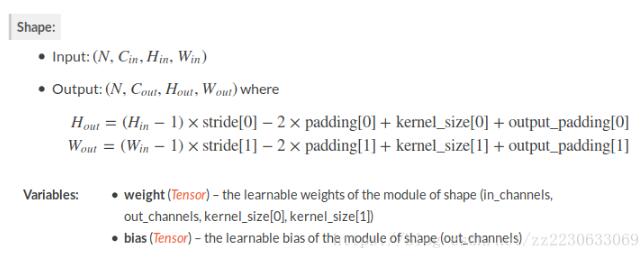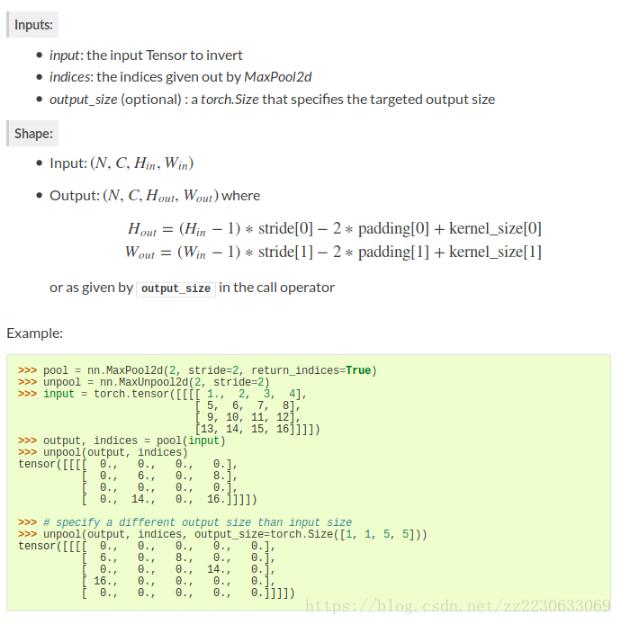pytorch中的上采样以及各种反操作,求逆操作详解
import torch.nn.functional as F
import torch.nn as nn
F.upsample(input, size=None, scale_factor=None,mode='nearest', align_corners=None)
r"""Upsamples the input to either the given :attr:`size` or the given
:attr:`scale_factor`
The algorithm used for upsampling is determined by :attr:`mode`.
Currently temporal, spatial and volumetric upsampling are supported, i.e.
expected inputs are 3-D, 4-D or 5-D in shape.
The input dimensions are interpreted in the form:
`mini-batch x channels x [optional depth] x [optional height] x width`.
The modes available for upsampling are: `nearest`, `linear` (3D-only),
`bilinear` (4D-only), `trilinear` (5D-only)
Args:
input (Tensor): the input tensor
size (int or Tuple[int] or Tuple[int, int] or Tuple[int, int, int]):
output spatial size.
scale_factor (int): multiplier for spatial size. Has to be an integer.
mode (string): algorithm used for upsampling:
'nearest' | 'linear' | 'bilinear' | 'trilinear'. Default: 'nearest'
align_corners (bool, optional): if True, the corner pixels of the input
and output tensors are aligned, and thus preserving the values at
those pixels. This only has effect when :attr:`mode` is `linear`,
`bilinear`, or `trilinear`. Default: False
.. warning::
With ``align_corners = True``, the linearly interpolating modes
(`linear`, `bilinear`, and `trilinear`) don't proportionally align the
output and input pixels, and thus the output values can depend on the
input size. This was the default behavior for these modes up to version
0.3.1. Since then, the default behavior is ``align_corners = False``.
See :class:`~torch.nn.Upsample` for concrete examples on how this
affects the outputs.
"""
nn.ConvTranspose2d(in_channels, out_channels, kernel_size, stride=1, padding=0, output_padding=0, groups=1, bias=True, dilation=1)
""" Parameters: in_channels (int) – Number of channels in the input image out_channels (int) – Number of channels produced by the convolution kernel_size (int or tuple) – Size of the convolving kernel stride (int or tuple, optional) – Stride of the convolution. Default: 1 padding (int or tuple, optional) – kernel_size - 1 - padding zero-padding will be added to both sides of each dimension in the input. Default: 0 output_padding (int or tuple, optional) – Additional size added to one side of each dimension in the output shape. Default: 0 groups (int, optional) – Number of blocked connections from input channels to output channels. Default: 1 bias (bool, optional) – If True, adds a learnable bias to the output. Default: True dilation (int or tuple, optional) – Spacing between kernel elements. Default: 1 """
计算方式:

定义:nn.MaxUnpool2d(kernel_size, stride=None, padding=0)
调用:
def forward(self, input, indices, output_size=None):
return F.max_unpool2d(input, indices, self.kernel_size, self.stride,
self.padding, output_size)
r"""Computes a partial inverse of :class:`MaxPool2d`.
:class:`MaxPool2d` is not fully invertible, since the non-maximal values are lost.
:class:`MaxUnpool2d` takes in as input the output of :class:`MaxPool2d`
including the indices of the maximal values and computes a partial inverse
in which all non-maximal values are set to zero.
.. note:: `MaxPool2d` can map several input sizes to the same output sizes.
Hence, the inversion process can get ambiguous.
To accommodate this, you can provide the needed output size
as an additional argument `output_size` in the forward call.
See the Inputs and Example below.
Args:
kernel_size (int or tuple): Size of the max pooling window.
stride (int or tuple): Stride of the max pooling window.
It is set to ``kernel_size`` by default.
padding (int or tuple): Padding that was added to the input
Inputs:
- `input`: the input Tensor to invert
- `indices`: the indices given out by `MaxPool2d`
- `output_size` (optional) : a `torch.Size` that specifies the targeted output size
Shape:
- Input: :math:`(N, C, H_{in}, W_{in})`
- Output: :math:`(N, C, H_{out}, W_{out})` where
计算公式:见下面
Example: 见下面
"""

F. max_unpool2d(input, indices, kernel_size, stride=None, padding=0, output_size=None)
见上面的用法一致!
def max_unpool2d(input, indices, kernel_size, stride=None, padding=0,
output_size=None):
r"""Computes a partial inverse of :class:`MaxPool2d`.
See :class:`~torch.nn.MaxUnpool2d` for details.
"""
pass
以上这篇pytorch中的上采样以及各种反操作,求逆操作详解就是小编分享给大家的全部内容了,希望能给大家一个参考,也希望大家多多支持猪先飞。
相关文章
pytorch nn.Conv2d()中的padding以及输出大小方式
今天小编就为大家分享一篇pytorch nn.Conv2d()中的padding以及输出大小方式,具有很好的参考价值,希望对大家有所帮助。一起跟随小编过来看看吧...2020-04-27- 这篇文章主要介绍了PyTorch一小时掌握之迁移学习篇,本文给大家介绍的非常详细,对大家的学习或工作具有一定的参考借鉴价值,需要的朋友可以参考下...2021-09-08
Linux安装Pytorch1.8GPU(CUDA11.1)的实现
这篇文章主要介绍了Linux安装Pytorch1.8GPU(CUDA11.1)的实现,文中通过示例代码介绍的非常详细,对大家的学习或者工作具有一定的参考学习价值,需要的朋友们下面随着小编来一起学习学习吧...2021-03-25- 这篇文章主要介绍了Pytorch之扩充tensor的操作,具有很好的参考价值,希望对大家有所帮助。一起跟随小编过来看看吧...2021-03-05
- 今天小编就为大家分享一篇pytorch 自定义卷积核进行卷积操作方式,具有很好的参考价值,希望对大家有所帮助。一起跟随小编过来看看吧...2020-05-06
- 这篇文章主要介绍了解决pytorch 交叉熵损失输出为负数的问题,具有很好的参考价值,希望对大家有所帮助。一起跟随小编过来看看吧...2020-07-08
pytorch绘制并显示loss曲线和acc曲线,LeNet5识别图像准确率
今天小编就为大家分享一篇pytorch绘制并显示loss曲线和acc曲线,LeNet5识别图像准确率,具有很好的参考价值,希望对大家有所帮助。一起跟随小编过来看看吧...2020-05-02- 这篇文章主要介绍了pytorch 实现冻结部分参数训练另一部分,具有很好的参考价值,希望对大家有所帮助。一起跟随小编过来看看吧...2021-03-27
从Pytorch模型pth文件中读取参数成numpy矩阵的操作
这篇文章主要介绍了从Pytorch模型pth文件中读取参数成numpy矩阵的操作,具有很好的参考价值,希望对大家有所帮助。一起跟随小编过来看看吧...2021-03-04Pytorch 的损失函数Loss function使用详解
今天小编就为大家分享一篇Pytorch 的损失函数Loss function使用详解,具有很好的参考价值,希望对大家有所帮助。一起跟随小编过来看看吧...2020-05-02- 今天小编就为大家分享一篇pytorch中的上采样以及各种反操作,求逆操作详解,具有很好的参考价值,希望对大家有所帮助。一起跟随小编过来看看吧...2020-04-30
- 今天小编就为大家分享一篇Pytorch实现LSTM和GRU示例,具有很好的参考价值,希望对大家有所帮助。一起跟随小编过来看看吧...2020-04-27
- 这篇文章主要介绍了基于Pytorch版yolov5的滑块验证码破解思路详解,本文给大家介绍的非常详细,对大家的学习或工作具有一定的参考借鉴价值,需要的朋友可以参考下...2021-02-25
解决Pytorch dataloader时报错每个tensor维度不一样的问题
这篇文章主要介绍了解决Pytorch dataloader时报错每个tensor维度不一样的问题,具有很好的参考价值,希望对大家有所帮助。如有错误或未考虑完全的地方,望不吝赐教...2021-05-28pytorch中交叉熵损失(nn.CrossEntropyLoss())的计算过程详解
今天小编就为大家分享一篇pytorch中交叉熵损失(nn.CrossEntropyLoss())的计算过程详解,具有很好的参考价值,希望对大家有所帮助。一起跟随小编过来看看吧...2020-05-02- 这篇文章主要介绍了pytorch深度学习中对softmax实现进行了详细解析,有需要的朋友可以借鉴参考下,希望能够有所帮助,祝大家多多进步...2021-09-30
- 今天小编就为大家分享一篇Pytorch 计算误判率,计算准确率,计算召回率的例子,具有很好的参考价值,希望对大家有所帮助。一起跟随小编过来看看吧...2020-04-27
- 这篇文章主要介绍了pytorch中的squeeze函数、cat函数使用,具有很好的参考价值,希望对大家有所帮助。如有错误或未考虑完全的地方,望不吝赐教...2021-05-20
- 这篇文章主要介绍了Pytorch如何切换 cpu和gpu的使用详解,文中通过示例代码介绍的非常详细,对大家的学习或者工作具有一定的参考学习价值,需要的朋友们下面随着小编来一起学习学习吧...2021-03-01
- 今天小编就为大家分享一篇pytorch动态网络以及权重共享实例,具有很好的参考价值,希望对大家有所帮助。一起跟随小编过来看看吧...2020-04-29
